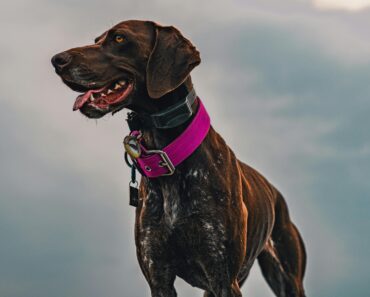Owning a dog is rewarding but comes with big responsibilities. We often wonder, “How long can I leave my dog alone?” The answer depends on many things. It’s important to find the right balance for your dog’s happiness and safety.
Key Takeaways
- Understand your dog’s unique needs and tolerance for alone time based on age, breed, and individual characteristics.
- Recognize the signs of distress in dogs left alone for too long, such as destructive behavior or excessive vocalization.
- Establish age-appropriate alone time guidelines to ensure your dog’s well-being and avoid potential risks.
- Prepare your home and provide engaging activities to make your dog’s alone time comfortable and enriching.
- Consider alternatives to leaving your dog alone, such as dog walkers, pet sitters, or doggy daycare centers, to meet their social and exercise needs.
Understanding Your Dog’s Needs
When you leave your dog alone, it’s key to know what they need. Each dog is unique, with different levels of tolerance and likes. Things like age, breed, and personality play a big role in how long they can be alone.
Factors Affecting Alone Time Tolerance
Puppies and young dogs need more attention and can’t be alone for long. Dogs with lots of energy, like herding or sporting breeds, also don’t like being alone much. Dogs that are anxious or needy find it hard to be alone at all.
Signs of Distress in Lonely Dogs
Watch for signs that your dog is feeling lonely when you’re away. Look out for too much barking, whining, or howling, acting out, and accidents in the house. These are signs they’re not happy being alone. Adjust your time away to keep your dog happy and healthy.
“A dog is a man’s best friend, but a man’s best friend cannot take care of himself when left alone for too long.”
The Risks of Leaving Dogs Alone Too Long
Leaving your dog alone for too long can be risky. It’s important to know the dangers to keep your dog safe and happy. Dogs can face behavioral and health issues if left alone too much.
Behavioral Concerns
Dogs love being around people and can get sad or act out if left alone too long. They might bark a lot, chew things they shouldn’t, or even become aggressive. These actions can upset your home life and harm your bond with your dog.
Health Risks
Being alone for a long time is bad for a dog’s health too. They might not get enough exercise or fun activities. This can make them gain weight, lose muscle, or even have heart problems. Dogs might also forget to drink water or go to the bathroom, which can be dangerous.
Safety Considerations
Leaving dogs alone for too long can also be dangerous. They might play with things they shouldn’t, like wires, or try to get out of the house. This can hurt them or someone else. Making sure your dog is safe when alone is very important.
Knowing the risks of leaving dogs alone helps pet owners make better choices. Creating a good routine, giving them lots of playtime, and thinking about other care options can help. These steps can keep your dog happy and safe.
| Behavioral Concerns | Health Risks | Safety Considerations |
|---|---|---|
| Separation anxiety | Obesity | Accidents or injuries |
| Excessive barking | Muscle atrophy | Hazardous material exposure |
| Destructive chewing | Cardiovascular issues | Escape attempts |
| Aggression | Neglect of basic needs | Potential harm to self or others |
“Leaving a dog alone for too long can lead to serious behavioral and health problems that jeopardize the dog’s well-being and the safety of the household.”
Age-Appropriate Alone Time Guidelines
Figuring out how long to leave your dog alone is tricky. The right amount depends on your dog’s age and life stage. Knowing what puppies, adult dogs, and senior dogs need helps keep them happy when you’re away.
Puppies and Young Dogs
Puppies and young dogs can’t handle being alone for long. Puppies should be left alone for 1-2 hours at a time, up to a max of 4 hours daily. As they grow, you can slowly increase this time. But, be careful. Young dogs need lots of social time, watching, and breaks to go outside, making it hard for them to be alone for a long time.
Adult Dogs
Adult dogs, usually 1-7 years old, can be alone more than puppies. Most adult dogs can stay alone for 4-8 hours a day, based on what they need and how they feel. But, remember to think about their breed, how much energy they have, and if they get anxious when left alone.
Senior Dogs
Older dogs have different needs as they age. Senior dogs, 8 years and up, shouldn’t be left alone for more than 4-6 hours a day. They might have health problems, move slower, or think differently, making them more sensitive to being alone for a long time.
No matter your dog’s age, watch how they act and change your alone time rules as needed. Giving them enough exercise, fun activities, and a safe place to be can help them do well when you’re not there.
Preparing Your Home for Your Dog’s Alone Time
It’s important to make your home safe and comfy for your dog when they’re alone. This helps them and you relax. Here are some tips to get your home ready for your pup’s solo time:
Establishing a Designated Space
Choose a special spot in your home for your dog. It could be a cozy corner, a room with their toys, or a crate with soft bedding. Having a familiar and safe space helps them feel calm when you’re not there.
- Provide a comfortable bed or blanket for your dog to rest on.
- Introduce calming scents, such as lavender or chamomile, to help soothe your dog.
- Ensure access to fresh water and their favorite chew toys or puzzle feeders to keep them entertained.
Minimizing Potential Hazards
Make sure your home is safe for your dog by checking for dangers. Secure loose wires, keep toxic substances away, and remove small objects that could be a choking hazard.
- Inspect your home for any accessible areas that could be dangerous for your dog.
- Invest in safety gates or crates to restrict access to certain rooms or areas.
- Consider leaving a radio or TV on to provide background noise and help create a safe space for dog alone time.
By making your home comfortable for dog alone time, you ensure your dog feels secure and happy when you’re away. This gives you peace of mind too.

“The key to a successful solo experience for your dog is to create a safe, comfortable environment that meets their needs.”
How Long Can You Leave a Dog Alone?
When thinking about “how long can you leave a dog alone?”, the answer changes based on several things. The right amount of alone time depends on the dog’s age, breed, and unique needs. Knowing these tips can keep your furry friend safe and happy when you’re not there.
Maximum Time for Leaving Dogs Alone
It’s wise to keep your dog alone for 4-6 hours max. Puppies and young dogs should not be left alone for more than 2-3 hours. Some older dogs and certain breeds might need even less time because they might get anxious or have other issues.
Breed and Size Considerations
Smaller breeds and toy dogs usually don’t like being left alone as much as bigger dogs. Breeds like Chihuahuas, Pomeranians, and Yorkies may get upset after just a couple of hours. On the other hand, big, independent breeds like Labradors and Golden Retrievers can handle up to 6 hours alone.
Recommended Time for Leaving Dogs Alone
- Puppies and young dogs (under 1 year): 2-3 hours maximum
- Adult dogs (1-7 years): 4-6 hours maximum
- Senior dogs (8 years and older): 2-4 hours maximum
Remember, these are just basic rules, and your dog might be different. If you’re not sure what’s best for your pet, talk to a vet or a dog trainer expert.
“The key is to gradually acclimate your dog to being alone, starting with short durations and gradually increasing the time as they become more comfortable.”
Alternatives to Leaving Your Dog Alone
As a pet owner, sometimes you might need to leave your furry friend alone. But leaving a dog alone for too long can be bad for them. It can cause behavioral problems or make them feel stressed. Luckily, there are other ways to keep your dog happy while you’re away.
Dog Walkers and Pet Sitters
One good choice is to hire a dog walker or pet sitter. They can come to your home during the day. They’ll give your dog the exercise, attention, and company they need. This keeps your dog from being alone and helps them stay active and happy.
Doggy Daycare Centers
Another option is to put your dog in a doggy daycare center. These places offer a safe space where your dog can play, make friends, and do fun activities with other dogs. The staff at these centers are trained to take good care of your dog all day. This lets you relax knowing your dog is in good hands.
When looking into these options, make sure to check out the providers. Look for ones that are known for being trustworthy and caring for pets well. By doing your homework, you can find the best place to keep your dog happy and healthy when you’re not there.
“A tired dog is a happy dog. Providing your pup with exercise and socialization while you’re away is the best way to ensure their wellbeing.”
Training Your Dog for Alone Time
Getting your dog used to being alone can change their life and yours for the better. It’s all about making them feel okay with being left by themselves. This is done through steps that help them get used to being alone.
Gradual Desensitization Techniques
The first step in training dog for alone time is to do it slowly. Start by leaving for just a little bit and then come back. Keep doing this, but leave for a bit longer each time. This way, your dog will get used to you being away without getting upset.
- Start with small steps, like leaving the room for a few seconds and then coming back. Slowly leave for longer periods, making sure your dog stays calm.
- Give your dog treats or praise when they act calm or quiet while you’re away. This training dog for alone time helps them know it’s okay.
- Use special words like “I’ll be back” to let your dog know when you’re leaving and coming back. This helps them understand it’s all good.
- Leave out toys, puzzle feeders, or chew bones to keep your dog busy while you’re away. This helps them stay happy and occupied.
Being consistent and patient is very important when training dog for alone time. With a careful plan, your dog will learn to be happy and secure when you’re not there.
“The key to a well-adjusted dog is gradual exposure to alone time, not sudden isolation.”
Keeping Your Dog Entertained and Engaged
As a pet owner, making sure your dog is happy and well when alone is key. Giving them fun activities and enrichment can really help. This keeps your dog happy and busy when you’re not there. By using different toys, games, and interactive stuff, you can stop boredom and help with separation anxiety.
Interactive toys are a great way to keep your dog busy. They make your dog think, chew, or work for treats. This keeps their mind and body active. Puzzle feeders, snuffle mats, and Kong toys with peanut butter or healthy snacks are good examples.
If your dog likes sounds or TV, try leaving the TV or radio on when you’re out. Calming music or nature sounds can soothe your dog and lower their stress. Or, you could look into pet streaming services with shows just for dogs.
- Change your dog’s toys often to keep them interested and curious.
- Give chew toys to let them gnaw and keep their teeth and jaws healthy.
- Use food-dispensing toys that make them work for their treats. This helps their mind and body.
It’s important to keep your dog entertained and engaged when you’re away. With different enrichment activities and toys, your dog will stay happy and well, even when you’re not there.

| Activity | Benefits |
|---|---|
| Interactive Toys | Encourage problem-solving, mental stimulation, and physical activity |
| Audio/Visual Stimulation | Provide soothing or engaging content to reduce anxiety and boredom |
| Chew Toys | Fulfill natural instincts and maintain dental health |
| Food-Dispensing Toys | Promote mental and physical engagement while providing a rewarding experience |
“A tired dog is a happy dog, and a happy dog is a well-behaved dog.” – Unknown
By trying out different engaging activities for your dog when alone, you can make sure they stay entertained and content when you’re away. This helps their overall well-being and strengthens your bond with your furry friend.
Conclusion
Knowing how long you can leave your dog alone is key for their happiness and health. This guide has given you a clear way to figure out the right amount of alone time. It depends on your dog’s age, breed, and unique needs.
To make sure your dog is happy alone, focus on their comfort, safety, and keeping their mind busy. Creating a safe, cozy spot and giving them fun activities can help ease any stress or anxiety.
The right answer to how long can you leave a dog alone changes for every dog. It’s important to watch your dog closely and change things as needed. Looking into key takeaways for leaving dogs alone, like using dog walkers, pet sitters, or daycare, can also help. These options can be good alternatives to leaving them alone for too long.





